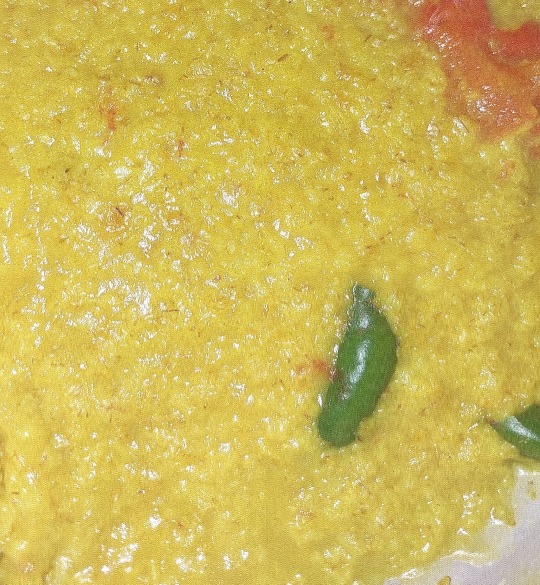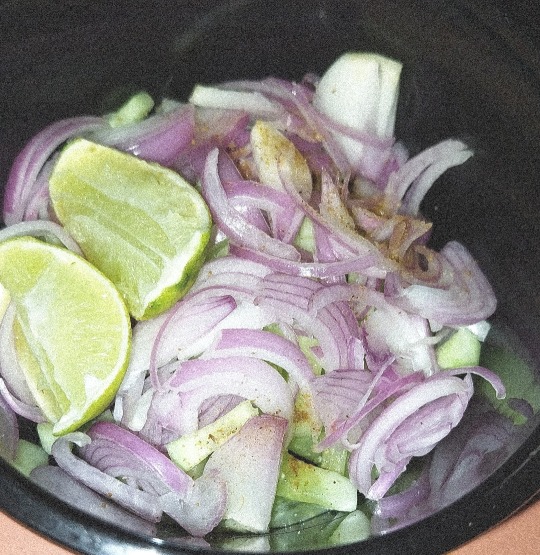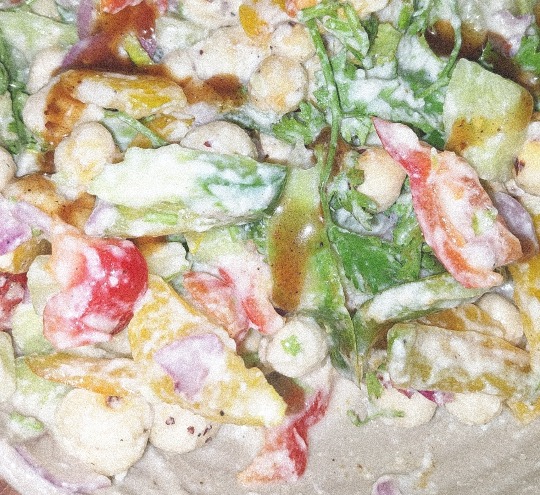#raw mango chutney
Explore tagged Tumblr posts
Text

Quichentell is one of my go-to places for wholesome, easy-to-make recipes that never compromise on flavor. I recently came across their recipe for Steamed Chicken Thighs, and it’s a game-changer! The chicken is marinated in a mix of soy sauce, fish sauce, and ginger, then steamed to perfection, making it tender and packed with flavor. What I love most is how they pair it with spinach-stuffed rice paper rolls—light, nutritious, and just the right amount of crunch. It’s the kind of recipe that makes you feel like you’re eating clean but still indulging in something truly delicious. If you’re into meals that are simple, healthy, and satisfying, you’ll love what Quichentell has to offer.
#Steamed Chicken Thighs#Keema Fried Rice#Gluten Free Ragi Bread#Prawn 65 Recipe#Raw Mango Chutney#Mango Phirni#Goan Crab Curry#4 Hour Baguette
0 notes
Text

Homemade Raw Mango Chutney Recipe
0 notes
Text
How To Make Aamer Chutney: This Chutney From Bengal Is Perfect For Summer
Chutneys are an essential component of Indian cuisine. They enhance the flavour of any dish by several notches and create a sensory experience in our mouths, making the entire meal enjoyable. Some chutneys offer numerous health benefits, which is why people enjoy pairing them with their everyday meals. Whether it’s pudina chutney, coconut chutney, tomato chutney, or amchoor chutney, the wide…

View On WordPress
#aamer#aamer chutney#bengali chutney#chutney recipe#chutney recipes#mango chutney#mango chutney recipe#mango chutney recipes#raw mango chutney
0 notes
Text
Mango Chutney | Breakfast Chutney
New Post has been published on https://hyderabadiruchulu.com/mango-chutney/
Mango Chutney | Breakfast Chutney

Print
Mango Chutney
Prep Time
10 mins
Cook Time
15 mins
Let's learn today how to prepare a spicy and tangy mango chutney using unripe mangoes. This seasonal chutney can be a great alternative to the usual coconut or peanut chutneys, and it goes well with a variety of breakfast dishes. With just a few simple steps, you can make this delicious mango chutney and enjoy the flavors of summer.
Course: Breakfast Chutney
Cuisine: Indian
Keyword: Breakfast Chutney, Instant Chutney, Mango Chutney
Servings: 8 people
Ingredients
2 Unripe Mango
7-8 Dried chilies
1 Onion diced
1 tsp Salt
1/4 cup Fresh coconut pieces or grated coconut
4-5 Garlic cloves
1 tsp Cumin seeds
1/2 tsp Turmeric powder
1/2 cup Curry leaves
2 tbsp Oil
Instructions
Here I used 2 mangoes
Peel and dice the mangoes
Heat 1 tbsp oil in pan
Add 7-8 dried chilies and fry till they change colour
Move them into a different plate
Then, add more oil to the pan
Now, add 1 diced onion and fry till they change colour
Add 1 tsp salt and fry
Cut off the stove and let it col down
To a mixie jar, add the fried onions, 1/4 cup fresh coconut pieces or grated coconut, 4-5 garlic cloves, 1 tsp cumin seeds, 1/2 tsp turmeric powder, 1/2 cup curry leaves, fried dried chilies along with the diced mango and grind it coarsely
Move it into a bowl and serve the mango chutney with your favourite breakfast
#easy breakfast chutney#green mango recipes#Hyderabadi Ruchulu#indira ireni#instant chutney#mango chutney#quick breakfast chutney#raw mango recipe#seasonal mango chutney#tangy mango chutney#unripe mango recipes
0 notes
Photo

In Living Color: A Prismatic Reading List on Pigment, Paint, and Perception
In Kanya Kanchana's latest reading list, she dives deep into our fascination with color:
"At my writing desk, I run my finger along the tiny glass vials into which I have decanted a dozen oils and potions—root and bark, leaf and flower, fruit and seed—just so I can look at them in the light. I shall make beetroot for lunch, I think, and wash drawing paper in the purple juice. Or perhaps tip a generous green palette into white—bruise spinach with green chilies and curry leaves in coconut oil; crush raw mango with coconut for a chutney; dust some basmati in powder of moringa. “To work magic, to put enchantments upon others, one has first to put enchantments on oneself,” writes Indologist and art historian Heinrich Zimmer. I must color myself so I can soak you in some."
Check out her six story selections.
123 notes
·
View notes
Text
As a teenager, I was embarrassed about liking chopped liver. To be fair, I was embarrassed about most things — my parents, my lack of the coolest sneakers, and my freckles among many other things. But liking chopped liver was high up on the list. It was just one of those gross foods: aesthetically unappealing, greyish and mushy, and just plain weird. None of my non-Jewish schoolmates had ever heard of anything like it.
But it tasted so damn good. All of it did — my grandmother’s, made from beef livers and shimmering with schmaltz served weekly at Shabbat lunch; the mass-produced packaged stuff that was kind of gristly, in a not-all-bad way; the scoops of it sandwiched between two slightly stale slices of white bread at the kosher deli (which may well have been the packaged stuff); and best of all, the creamier pate-like offerings, topped with a sweet fruit chutney, served at Friday night buffets in Israeli hotels. Chopped liver was rich and didn’t require a lot of effort — you barely needed to chew it. It also sparked an iron-fueled rush of energy. It was my guilty pleasure.
I didn’t realize I had been so spoiled in the chopped liver department until I left home from England, to Israel, where it was actually quite hard to find. Israeli chefs were deep into a returning-to-culinary-roots movement but hadn’t really delved into the Ashkenazi kitchen yet, preferring the spicier, sexier Mizrahi dishes like kubbeh and upscale stuffed pita sandwiches. I could find chopped liver in haredi areas like Bnei Brak, but it was a real schlep.
So I did what any committed liver enthusiast would do: I started making my own. I had my grandmother’s recipe, but beef livers were hard to come by, so I set my sights on a chicken liver version I’d found in Geila Hocherman’s Kosher Modern cookbook. This was more a pate; it departed from tradition in some quite ballsy ways, like adding capers! And thyme! And chili flakes! I was intrigued.
Finding chicken livers wasn’t a problem — there were trays of them, slippery and pink, in the Carmel Market in Tel Aviv. And, like those my Ashkenazi ancestors cooked within Eastern Europe, they were cheap and sold raw. Back at home, I gave my grandmother a call and she, delighted by my culinary undertaking, gave me step-by-step instructions. First I had to rinse the livers, salt them, and broil them — this was going to take some time.
I tend to be an impatient cook — technique-heavy, complicated recipes bring out the worst in me. But the process of making chopped liver was unexpectedly enjoyable. Growing up in an Orthodox community, my role as a woman often felt passive, mostly consisting of watching the men participate in Judaism. So it felt new, and welcome, to take on the active task of preparing the livers, with instructions passed down through my matriarchs for generations.
Once they’d been sufficiently broiled on both sides, I added the livers to a pan with caramelized onions, capers, thyme chili flakes, and a splash of white wine. Then I blitzed the mixture and a few slices of soaked bread with a hand mixer and steeled myself for a taste.
While the unorthodox ingredients added a saline spurt and chili zing, the chopped liver tasted wonderfully familiar. It was my take on all the other versions I’d gorged myself on before — not competing with them, but adding something a little new. I was content and even proud. I sat at the kitchen table with a glass of red wine, a box of crackers, and a jar of mango chutney and ate half my homemade liver in one sitting. Not the healthiest snack, I grant you, but it was an important reminder to me that sometimes it is worth investing time in the kitchen to please only yourself. Making chopped liver began as an exercise in nostalgia but turned out to be much more — an act of culinary self-care.
7 notes
·
View notes
Text
Akshay Mehndiratta : Summer Special Light Meal Ideas From Across India

During the hot summers in India, people are eager to eat cool and tasty food to feel good. Akshay Mehndiratta, who loves food and trying new things, travels across India to taste different summer dishes. In this blog of Akshay Mehndiratta, you will find some foods that you should eat during summer, which will make you happy.
Delhi Street Food: Tasty Chaat
Akshay enjoys a variety of street foods when walking through Delhi’s crowded streets, his favorite dish in delhi is chaat. He also like meals like aloo tikki chaat and papdi chaat, which blend sweet, sour, and spicy ingredients such as tamarind chutney, spicy coriander chutney, and chaat masala to please your taste buds. Chaat is a popular snack offered throughout India, with each area having its own unique recipe. Akshay Mehndiratta, pictures Delhi’s street cuisine and enjoys every mouthful.
Gujarati Treats: Fluffy Dhokla
When Akshay Mehndiratta went to Gujarat, he had a delightful breakfast called dhokla, which was light and tasty. Akshay appreciated the traditional steamed dhokla and the many varieties of dhokla, including unusual flavors like spinach and corn. This dish is prepared using gram flour, spices and lemon juice. Being high in protein, fiber and other minerals, it is an excellent supplement to any weight loss diet.
Kolkata’s Famous Rolls: Kathi Rolls
In Kolkata, Akshay had the pleasure of eating excellent kathi rolls from street vendors. Kathi rolls are a delicacy made with a mixture of spicy vegetables and wrapped in a crispy bread called paratha. This meal is perfect to eat while traveling in the hot sun. This popular street food of Kolkata is a favorite and tasty meal that really impresses everyone.
South Indian Crispiness: Delicious Dosas
Akshay Mehndiratta traveled to a peaceful place in South India. He ate the amazing dosa there. Dosa is a unique dish that is loved by everyone. There are many varieties of dosa, each with its own flavor and spices. Along with traditional masala dosa, Akshay also ate Mysore masala dosa and rava dosa. Each dosa has a distinct taste. He ate the dosa with coconut chutney and spicy sambar, which made it even more delicious. This was an excellent dinner for a South Indian summer.
Rajasthani Retreat: Thali Temptations
When Akshay Mehndiratta visited Rajasthan, he tried a rare meal called Rajasthani Thali. The platter was filled with colorful and delectable foods that reflected the region’s culinary heritage. It serves spicy meals, spicy pickles, fresh salads, and sweet dishes that accentuate Rajasthan’s distinct flavors.
Maharashtrian Refreshment: Cooling Sol Kadhi
While traveling to the western state of Maharashtra, Akshay enjoys Sol Kadhi, a traditional drink that is perfect to beat the heat. Made with coconut milk, kokum (a tropical fruit), and green chilies, garlic, and cilantro, Sol Kadhi is a refreshing and tangy concoction that helps cool the body and aids digestion. Served chilled, this pink colored drink is a popular dish with food during the scorching summers of Maharashtra, offering a rich flavor and respite from the sun’s rays.
Uttar Pradesh’s Summer Classic: Chilled Aam Panna
Heading to Uttar Pradesh, Akshay Mehndiratta, gets a refreshing twist on the classic summer drink Aam Panna, raw mango, mint and spices. Known for its cooling properties and tangy-sweet taste, mango panna is a popular thirst quencher during the hot summer months. Made by boiling raw mangoes until soft, then adding fresh mint leaves, roasted cumin powder, black salt and sugar, this cool drink is both refreshing and nutritious. Whether enjoyed as a mid-day refresher or served with a light summer meal, aam panna is a summer favorite in Uttar Pradesh and beyond, offering a delightful way to beat the heat and stay hydrated.
Conclusion:
As Akshay Mehndiratta spends the summer tasting various cuisines across India, he reveals in this blog how diverse, inventive and delicious Indian cuisine is. From bustling metropolises to serene beaches, every part of India offers its own favorite and refreshing summer meal. Akshay loves to try new foods and share them with others so that people can understand about the food and enjoy them.
2 notes
·
View notes
Text
Day 6 of getting my sh!t together!
Hello! Today was a productive day, even though it started late. I managed to sneak in a quick workout after having my morning coffee and burn the calories from yesterday's celebratory food fest. I told you I skip workout with any VALID excuse, but I make sure to do it on days that I am well and there's no excuse. The first meal of the day was my late brunch, and it was good. I managed to finish work early as well. Dinner was light and fulfilling.
Here's the menu for today:
Black Coffee

Brunch:
1)Oats khichdi
2)Chana paneer
3)Salad
4)Raw mango chutney (forgot to click picture)
5)Yoghurt




Evening:
Just black coffee
Dinner:
Foxnut Salad With Yoghurt Dressing

I am feeling sleepy now so Imma doze off. But before that, here's my song recommendation for the day!
#writers on tumblr#new on tumblr#thoughts#getting my life together#day 6#writerscommunity#getting my shit together#i am so tired#newbie#100 days of productivity#what i eat to lose weight#what i eat in a day#low cal restriction#calorie deficit diet#caloric deficit#low cal diet#low calorie meals#what i eat in calorie deficit#calories#healthy#healthylifestyle#balanceddiet#writers and poets#i am a mess#soups and stews#boys over flowers#because i'm stupid#eat your veggies#low effort#foodie
2 notes
·
View notes
Text
Cooking as a Form of Self-Care: How Spending Time in the Kitchen Can Be Therapeutic
In our fast-paced lives, where stress and responsibilities often take precedence, finding moments of solace can be a challenge. For many, the kitchen is not just a place to prepare meals; it is a sanctuary where they can unwind, express creativity, and practice mindfulness. Cooking has emerged as a powerful form of self-care, offering therapeutic benefits that nourish both the body and mind.

The Therapeutic Power of Cooking
Cooking engages all the senses—the aroma of spices, the vibrant colors of fresh vegetables, the rhythmic sound of chopping, and the tactile joy of kneading dough. These sensory experiences can ground you in the present moment, much like meditation. The act of creating something with your hands, whether it’s a simple dish or a gourmet meal, can provide a sense of accomplishment and boost your mood.
Psychologists have even identified cooking as a form of behavioral activation, a therapeutic technique that helps alleviate symptoms of depression by encouraging individuals to engage in meaningful activities. The process of planning, preparing, and savoring a meal can break negative thought patterns and foster a sense of control and purpose.
Cooking for Yourself: A Gesture of Self-Love
In a world where convenience often trumps quality, cooking for yourself can feel like an act of rebellion—a declaration that your well-being matters. Preparing a wholesome meal tailored to your tastes and dietary needs is a way to nurture your body and show yourself care. Whether it’s a comforting bowl of Goan Crab Curry or a freshly baked loaf of Gluten Free Ragi Bread, the dishes you prepare can become tangible expressions of self-love.
Creativity in the Kitchen
The kitchen is a playground for creativity. Experimenting with new ingredients, flavors, and cuisines can be both exciting and fulfilling. Trying your hand at complex recipes like Goan Crab Curry allows you to immerse yourself in the culinary traditions of another culture, while experimenting with baking Gluten Free Ragi Bread offers a chance to explore healthier alternatives. These culinary adventures can spark joy and reignite your passion for life.
Mindful Cooking: A Path to Inner Peace
Cooking mindfully means being fully present during the process. Instead of rushing through meal prep, take the time to appreciate each step. Feel the texture of fresh produce, inhale the fragrance of herbs, and savor the first taste of your finished dish. Mindful cooking can reduce stress, improve focus, and create a sense of calm.
Sharing the Joy
While cooking for yourself is an essential part of self-care, sharing your creations with loved ones can be equally rewarding. The act of cooking for others fosters connection and strengthens relationships. Inviting friends over for a meal or surprising someone with a homemade treat can bring immense satisfaction and reinforce the bonds that sustain us.

Conclusion
Cooking as a form of self-care is about more than just feeding yourself; it’s about nourishing your soul. Whether you’re crafting a traditional Goan Crab Curry, experimenting with Gluten Free Ragi Bread, or simply making a comforting pot of soup, the act of cooking can be a powerful tool for self-expression, mindfulness, and emotional well-being. So, the next time you feel overwhelmed, step into the kitchen—you might just find the therapy you need simmering in a pot or rising in the oven.
#Prawn 65 Recipe#Prawn 65#Raw Mango Chutney#Mango Phirni#Keema Pulao Recipe#Keema Pulao#Goan Crab Curry
0 notes
Text
How To Make Kairi Ki Chutney - A Sweet And Tangy Chutney Perfect For Summer
Have you ever questioned what makes Indian delicacies so distinctive? The reply lies in its big selection of flavorful dishes that go well with each form of palate. And one thing that takes the flavour of such dishes up a notch is our beloved chutney. Indian chutneys have been a vital a part of our delicacies since time immemorial and might be present in varied varieties. The better part is that…

View On WordPress
#chutney#chutney recipes#kairi chutney#mango#mango chutney#mango chutney recipe#mango chutney recipes#raw mango#raw mango chutney
0 notes
Text
I made guacamole for the first time today. In fact, I had an avocado for the first time today. My mom fried up some stale-but-deliberately-so-chapatis cut in slices and I made the guac with onion, tomato, green chilli, garlic, lemon juice, salt, black pepper, and chat masala (very important). The rest of my family sprinkled their chapati chips with salt and red chilli powder and ate them with the guac and schezwan sauce, which is...a Choice but it tasted good I bet. I thought avocados would have a lot more flavour though, it didn't really do anything taste-wise? If I buy any again I'll try adding raw mango pieces to the guac. My dad suggested using kairi (raw mango) itself as a base instead of avocado to make a mango chutney (more of a koshimbir (raita)) of sorts. I don't know how the texture will work out with that but I think it could work with a less sour kairi? Results awaited
#food#My family is weird because they are All That but we also do have fun together and get along very well
4 notes
·
View notes
Text
I found out buying eggs from local market is cheaper than buying them from doorstep delivery apps. I guess I have to crawl down the street
1 hour later - I bought 12 eggs costing 72 rupees saving 20 bucks. I also brought along a raw mango and 100 grams of curry leaves. I am thinking of making pulse potion with raw mango pulps. For breakfast, I will make coconut chutney with dash of fried curry leaves to be served with idli.
1 note
·
View note
Text
OP where is the rice option
home is chicken biryani with mango pickle and plum chutney at family gatherings
home is khichuri with beef and salted ghee on a rainy day
home is white rice in lentil soup with salt, raw onion, lime juice and chilis on a hot summer's day
home is in the bowl of rice
reblog for larger polling please 🖤
9K notes
·
View notes
Text




January 25, 2025
dinner and dessert... the NYT's quinoa and broccoli spoon salad and modern honey's levain copycat chocolate chip crush cookies.
i'm happy with how the salad turned out; neither the recipe nor type of food are the norm for me but it was delicious. almost no notes, except that it, of course, took over double the expected amount of time to throw together. it does make a lot of (scrumptious) food though and requires very little "cooking", so i don't mind. despite eating two portions, there was still plenty left over. very solid recipe with a little bit of everything; the ratio of all the ingredients is perfect in that they all blend together well without overshadowing each other and without producing any offensive, imbalanced taste. i'm personally not a fan of raw broccoli but for once i can say that the subtle raw taste and crunchy texture added to the meal. miracles can happen when you actually follow a recipe! (even went out of my way to obtain dijon mustard... or rather, asked for it to be bought)
i overbaked the cookies a bit but am still happy with them; it just means the outside layer of crunch is a bit thicker than preferred. something about the baking time or temperature wasn't quite right so i ended up having to bake them almost 3x as long... it was during that third bake that it stayed in perhaps 2 minutes too long. i'm not sure if maybe the recipe is incorrect (calls for 410 degrees F which seems too high, but doesn't seem like others have issue) or maybe it's my oven, but the baking instructions were definitely off, as the outside baked while the inside stayed raw - hence the triple bake (lowered the temperature as well so it wouldn't burn). the recipe calls for a light-colored cookie sheet which i don't have, so that likely contributed to the uneven baking, but regardless the time listed would have yielded a raw cookie... i don't know. onto the positives, it's so good. fluffy on the outside, with a nice buttery texture that entices you to break a piece off. i like that it doesn't need any chilling, and it retains its shape well in the oven; i was very worried the cookies would melt in the oven! i did have to swap the walnuts with pecans but i think they serve similar purposes. i think next time around i'll use larger chocolate chips and chop the nuts smaller... it's such a decadent treat that i don't want to have to chew, haha.
the chips and two of the dips (mango chutney, garlic ) were purchased from roti brothers, the last (beet hummus) is from obour foods. i don't want to talk about how much those costed. anyway, they were massively delicious.
0 notes
Text
The Role of Chutneys and Pickles in Enhancing Indian Flavours
When exploring Indian cuisine, one cannot overlook the importance of chutneys and pickles. These delightful condiments are not mere accompaniments but integral components of the culinary experience. Chutneys and pickles add a burst of flavour, elevating even the simplest dishes. For those searching for "Indian food near me," these staples offer a taste of India’s rich culinary heritage.
Understanding the Basics: What Are Chutneys and Pickles?
Chutneys
Chutneys are flavour-packed condiments made from fruits, vegetables, herbs, and spices. They can be sweet, spicy, tangy, or a combination of these, depending on the ingredients and preparation methods. Popular chutneys include mint chutney, tamarind chutney, coconut chutney, and tomato chutney.
Pickles
Pickles, known as achar in India, are tangy and spicy preserves made by marinating vegetables or fruits in oil, salt, and spices. Unlike Western pickles, which are usually vinegar-based, Indian pickles rely heavily on regional spices and often include oil as a key preservative. Mango, lime, and mixed vegetable pickles are household favourites.
The Significance of Chutneys in Indian Cuisine
Balancing Flavours
Chutneys are masters of balance. Whether you are eating something rich and creamy like butter chicken or something dry like samosas, chutneys provide the perfect contrast. A dollop of mint chutney with samosas or tamarind chutney with pakoras cuts through heaviness and adds brightness to the dish.
Enhancing Everyday Meals
Indian households often include chutneys as part of their daily meals. They complement dishes like dosa, idli, and parathas, turning simple meals into flavourful feasts. The freshness of a mint-coriander chutney, for instance, lifts a plate of piping-hot pakoras to a whole new level.
Cultural and Regional Variations
Chutneys vary widely across India, reflecting the diversity of its culinary traditions. For example:
South India: Coconut chutney is a staple and often paired with dosa or idli.
North India: Mint-coriander chutney is a common accompaniment to kebabs and tandoori dishes.
East India: Tomato and mustard seed chutneys are local favourites.
The Unique Appeal of Indian Pickles
A Burst of Flavour
Indian pickles are known for their intense flavours, combining sour, salty, spicy, and even sweet notes. A spoonful of pickle can transform a plain bowl of rice or roti into a satisfying meal.
Preserving Traditions
The art of pickle-making is deeply rooted in Indian culture. It is often a communal activity, with families coming together to prepare jars of pickles that can last for months. This tradition is not just about food preservation; it also fosters a sense of togetherness.
Health Benefits
Indian pickles are not only about taste but also about health. Ingredients like mustard seeds, fenugreek, and asafoetida, commonly used in pickles, have digestive benefits. Fermented pickles also contribute to gut health by promoting good bacteria.
Versatility in Pairing
Pickles pair well with almost everything in Indian cuisine. From plain rice and dal to elaborate biryanis, they add a tangy kick that enhances the overall meal.
How Chutneys and Pickles Complement Indian Street Food
Indian street food is incomplete without chutneys and pickles. Whether it’s chaat, vada pav, or pani puri, chutneys are crucial for achieving the signature flavours. Tamarind chutney adds sweetness and tanginess, while spicy green chutney brings heat. Similarly, pickled onions or raw mango pickles are often served alongside to add crunch and zing.
Chutneys and Pickles: A Global Appreciation
For those seeking "Indian food near me," chutneys and pickles offer a glimpse into India’s culinary versatility. They have also found a place in global cuisines, with people incorporating them into sandwiches, wraps, and even cheese platters. Their adaptability has made them a favourite beyond Indian borders.
Making Chutneys and Pickles at Home
While many enjoy store-bought varieties, nothing beats the taste of homemade chutneys and pickles. They are easy to customise according to your taste preferences. Here are some tips:
Chutneys: Blend fresh ingredients like mint, coriander, green chillies, and lemon juice for a refreshing chutney. Experiment with adding peanuts or coconut for a richer texture.
Pickles: Marinate vegetables or fruits in oil, salt, and spices. Let them mature in sunlight for a few days for the flavours to deepen.
The Role of Chutneys and Pickles in Modern Dining
As Indian cuisine evolves, chutneys and pickles continue to adapt. They are now featured in fusion dishes, such as chutney-filled sandwiches or pickled mango salsa. This modern twist makes them more accessible to a global audience while staying true to their roots.
Chutneys and pickles are not just condiments; they are flavour enhancers that embody the essence of Indian cuisine. From balancing flavours to preserving traditions, they play a crucial role in every meal. For those searching for "Indian food near me," these delightful accompaniments offer a journey into the heart of India’s rich culinary heritage. Whether enjoyed with traditional dishes or modern creations, chutneys and pickles remain timeless staples that add depth and excitement to every bite.
Asees Indian Restaurant
52/54 Crown St,
Wollongong NSW 2500, Australia
02 4225 0481

0 notes